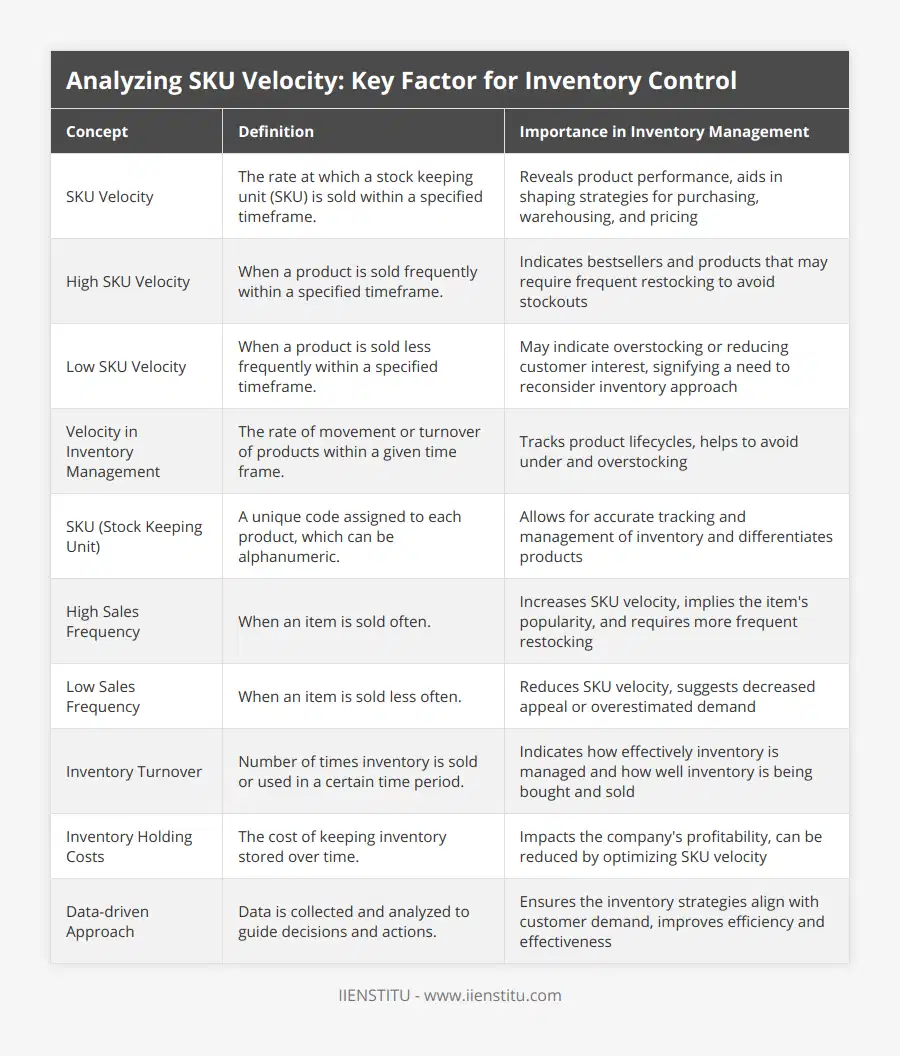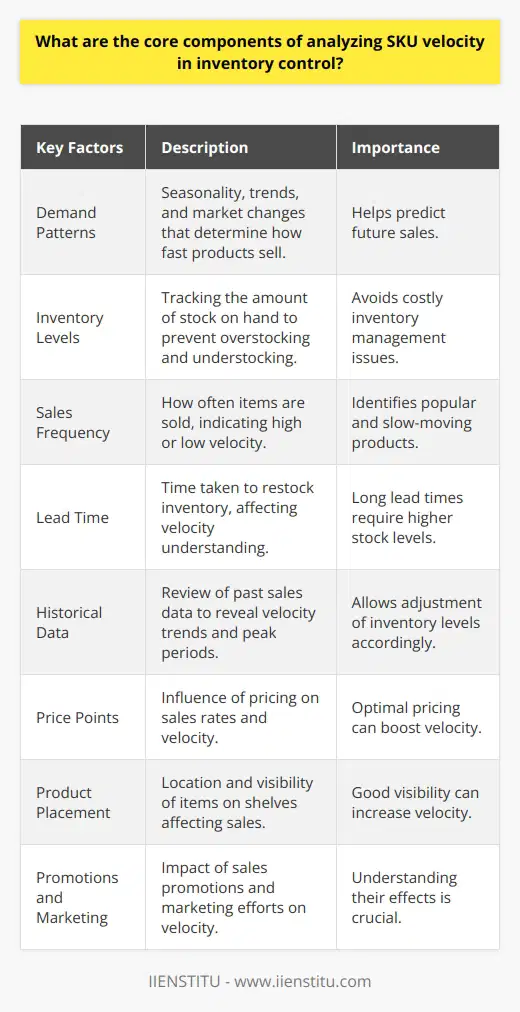
In the intricate dance of inventory management, understanding the subtle yet critical metrics that underpin the system's efficacy is paramount. Of these, SKU Velocity emerges as a linchpin, profoundly influencing stock control decisions and overall business health. This article seeks to elucidate the concept of SKU Velocity, a term that may sound technical but serves as a vital indicator for retailers, wholesalers, and distributors alike. Through a detailed exploration of its components, impact on inventory strategies, and applications in real-world contexts, we aim to decode how this key factor can be harnessed to streamline and bolster inventory control processes.
Introduction to SKU Velocity
Definition of SKU Velocity
The velocity of a stock keeping unit (SKU), a key metric in logistics management, gauges the speed at which an SKU is sold within a specified timeframe. This metric is essential for inventory managers in online courses to understand product performance.
It highlights which products are fast-moving and major contributors to revenue, as opposed to slow-moving items that can drain resources and risk becoming dead stock. SKU velocity is a pivotal factor in shaping strategies for purchasing, warehousing, and pricing in logistics management courses.
Brief about the importance of SKU Velocity in inventory management
Measuring SKU Velocity provides an immediate insight into the health of a product's sales and storage efficiency. Products with high SKU velocities are likely to be bestsellers and therefore require careful stock management to prevent stockouts.
Conversely, items with low SKU velocities may indicate overstocking or waning customer interest—signals for managers to reconsider their approach. It's clear that SKU Velocity not only impacts day-to-day operations but also plays a pivotal role in long-term inventory planning.
Explanation of the benefits of understanding SKU Velocity
Grasping the nuances of SKU Velocity enables businesses to optimize their order quantities, improve inventory turnover, reduce holding costs, and refine their product assortments.
It's a vital statistic that supports a data-driven approach to supply chain management, ensuring that companies keep their offerings fresh and aligned with customer demand. Having a handle on SKU Velocity can be the difference between a thriving business and one that's struggling to move its merchandise.
Understanding the Basics of SKU Velocity
Explanation of SKU (Stock Keeping Unit)
What SKU is and its role in inventory management
An SKU is a unique alphanumeric code assigned to each product on the shelf. This identifier allows for accurate tracking and management of inventory items, including their pricing, product options, and stock levels.
In inventory management, SKUs are integral in differentiating products, making it possible to monitor individual item movements, and serving as the bedrock upon which systems like SKU Velocity are built.
SKU structure and examples
SKUs are typically structured to include information pertinent to the item, such as the supplier code, product category, and specific attributes like size or color.
As an example, a black, medium-sized T-shirt from Supplier Z might have an SKU that looks like this: Z-TS-BLK-M. This structure streamlines operations by providing a quick reference to the precise characteristics of each item in inventory.
The Concept of Velocity in Inventory Management
Understanding the term 'velocity' in the context of inventory management
In the scope of inventory management, 'velocity' refers to the rate of movement or turnover of products within a given time frame. It's an expression of the cadence at which inventory is ordered, sold, and restocked—essentially gauging the pulse of a product's lifecycle.
The relevance of velocity in tracking product performance
Velocity serves as a pertinent indicator of product performance, revealing trends that impact various aspects of business operations.
High-velocity items demand attention to avoid empty shelves, while low-velocity products might need promotional efforts or discontinuation. Tracking SKU Velocity, therefore, provides a snapshot of what's hot and what's not, steering the company toward more informed, strategic choices.
Factors Affecting SKU Velocity
The Sales Frequency
An exploration of how sales frequency influences SKU velocity
Sales frequency, or how often an item is sold, directly affects SKU velocity. A high sales frequency translates to a high SKU velocity, suggesting that the item is popular with customers and may require more frequent restocking to maintain service levels.
Contrarily, a low sales frequency reduces the SKU velocity, potentially signifying a product's diminished appeal or an overestimated demand.
Examples of products with high and low sales frequencies
High-frequency sales items might include everyday essentials such as toiletries or staple foods, which naturally have a high SKU velocity due to constant demand.
On the other hand, luxury items or seasonal decorations tend to have a lower sales frequency, leading to a slower SKU velocity which necessitates optimized stocking periods.
The Impact of Seasonality
An assessment of how seasonal trends affect SKU velocity
Seasonality can cause significant fluctuations in SKU velocity. Many products see demand that aligns with seasons or holidays—for instance, swimwear SKU Velocity soars in the summer months, while it plummets during colder seasons.
Understanding seasonal trends is vital in predicting changes in SKU velocity and planning accordingly.
Case studies representing the influence of seasonality on SKU velocity
A case study might examine a retailer that sells garden furniture, noting an increase in SKU Velocity in spring and summer when customers are preparing their outdoor spaces.
By anticipating this seasonal demand, the retailer can adjust inventory levels to optimize stock turnover and minimize overstocking during off-peak times.
The Role of Promotions and Discounts
Discussion on how promotions and discounts can speed up SKU velocity
Promotions and discounts are tools often used to manipulate SKU velocity. By temporarily lowering prices, businesses can incentivize customers to purchase more of certain items, thus increasing the SKU velocity.
This can be particularly useful for moving excess stock or for giving a boost to new or underperforming products.
Examples illustrating the impact of promotional campaigns
Consider a scenario where a new line of kitchen appliances is launched but fails to reach expected sales targets. By implementing a discount campaign, the retailer not only clears space for more in-demand products but also potentially hooks new customers into trying the brand, therefore affecting the SKUs velocity.
Calculating SKU Velocity
Explanation of How to Calculate SKU Velocity
The calculation of SKU Velocity involves quantifying the number of times a product is sold and replaced over a selected period. In essence, this requires the total quantity of units sold to be divided by the number of days in the time frame, offering a daily, weekly, or monthly velocity.
Explore the importance of accurate calculation for effective inventory management
Accurate SKU Velocity calculation is indispensable for effective inventory management. It ensures that correct order quantities are determined, preventing both overstocking and stockouts. It also allows companies to make data-driven forecasting decisions, allocate warehouse space efficiently, and develop targeted sales strategies.
Step-by-Step Guide to Calculating SKU Velocity
Identifying the necessary data for calculation
To calculate SKU Velocity, one must first gather sales data for the SKU in question over a given period, as well as the number of days in that period. This data can be obtained from sales reports, inventory management systems, or the point-of-sale system.
Step-by-step process in calculating SKU velocity
Here's a simplified process for calculating SKU Velocity:
Determine the total units sold of a specific SKU within the chosen period.
Count the number of days within that period.
Divide the total units sold by the number of days to find the SKU Velocity.
This result informs inventory management decisions and can be used to track changes over time.
How to Use SKU Velocity to Optimize Inventory Management
The Use of SKU Velocity in Inventory Forecasting
How SKU velocity supports accurate forecasting
SKU Velocity is instrumental in driving accurate inventory forecasting by projecting future sales based on historic data. Businesses can leverage this information to predict which products will need replenishment, ensuring optimal stock levels are maintained and capital is not tied up in underperforming inventory.
Case study demonstrating forecasting using SKU velocity
A retailer could analyze SKU Velocity data from the previous year to forecast demand for the upcoming holiday season.
This could include ramping up orders for high-velocity gift items while scaling back on products with historically lower seasonal sales, ensuring that the shelves are stocked with the right mix of products at the right time.
SKU Velocity in Inventory Turnover Assessment
Role of SKU velocity in assessing how swiftly inventory is being sold and replaced
Inventory turnover, a measure of how quickly inventory is sold and replaced, is deeply intertwined with SKU Velocity.
High SKU Velocity indicates rapid turnover, which is often correlated with good inventory health, reflecting efficient use of capital and warehouse space. Monitoring SKU Velocity helps maintain a brisk inventory turnover, which is essential to profitability.
Real-world example of using SKU velocity in assessing inventory turnover
For example, a successful electronics store may have high SKU Velocities for its latest smartphones, indicating frequent turnovers. These insights could prompt the store to prioritize these items for restocking and focus on selling strategies that target this fast-moving inventory.
Leveraging SKU Velocity to Improve Sales Strategies
How understanding SKU velocity can drive better sales strategies
A deep understanding of SKU Velocity can inform and refine sales strategies. Products with high velocities can be leveraged as loss leaders or bundled with slower-moving items to increase overall sales.
Meanwhile, strategies for low-velocity items might focus on improvement or discontinuation decisions.
Examples demonstrating the implementation of strategies based on SKU velocity insights
Consider a bookstore that identifies a high SKU Velocity on classic novels. By bundling these with slow-moving accessories, such as bookmarks or reading lights, the store might boost sales for both. The strategy uses the allure of the fast-moving item to increase exposure and sales of the slower one.
Conclusion: The Power of SKU Velocity in Inventory Management
Recap of the importance of SKU velocity
SKU Velocity holds significant sway over many aspects of inventory management. It informs purchasing decisions, guides warehousing strategies, and shapes sales and marketing tactics. Its power lies in the granular insight it provides into product performance, allowing for more targeted and efficient decision-making.
Encouragement for businesses to utilize SKU velocity for improved inventory management
Businesses are well-advised to harness the analytical power of SKU Velocity to sharpen their inventory control. Those who regularly measure and act upon SKU Velocity data can expect to see notable improvements in stock turnover, revenue growth, and overall operational agility.
Final thoughts on the potential benefits of understanding and applying SKU velocity
As enterprises strive to maintain a competitive edge in a dynamic market, SKU Velocity emerges as a beacon, guiding them toward inventory management excellence. Its application can lead to leaner, more responsive operations, which not only reduce waste but also enhance customer satisfaction through better availability of desired products.
In summary, SKU Velocity is not just a metric; it is an indispensable component of a sophisticated inventory strategy. Those who invest time in understanding and applying SKU Velocity are setting the stage for sustainable business success.

Frequently Asked Questions
What are the core components of analyzing SKU velocity in inventory control?
Understanding SKU Velocity
SKU velocity measures the rate at which inventory sells. It dictates restocking. High velocity implies quick turnover. Low velocity suggests slow-moving stock.
Core Components
Analyzing SKU velocity involves several key factors.
Demand Patterns.
They determine how fast products sell. Factors such as seasonality, trends, and market changes are crucial. Understanding these helps predict future sales.
Inventory Levels.
You must track how much stock is on hand. This measure prevents overstocking and understocking, both of which are costly.
Sales Frequency.
How often items sell counts. Regularly sold items show high velocity.
Lead Time.
Lead time affects velocity understanding. It is the time taken to restock. Long lead times need higher stock levels.
Historical Data.
Review past sales data. It reveals velocity trends. You notice peak periods and adjust accordingly.
Price Points.
Price influences sales rates. Optimal pricing boosts velocity.
Product Placement.
Where items sit on shelves matters. Good visibility can increase sales.
Promotions and Marketing.
Sales promotions affect velocity. Understanding their impact is key.
Analyzing SKU Velocity
Data collection comes first. Employ inventory management systems for real-time tracking.
Next, apply analytics. Determine average sales for each SKU. Compare these against stock levels. Identify patterns in demand fluctuations.
Address low-velocity issues. Explore marketing or discounting for slow-moving items. Consider discontinuing them altogether.
For high-velocity items, ensure adequate inventory. Avoid stockouts as they lead to missed sales. Balance inventory to meet demand without overstocking.
Perform regular analyses. Markets evolve. Your SKU velocity strategy must adapt too.
Analyzing SKU velocity is complex but essential. A streamlined inventory ensures customer satisfaction. It optimizes profitability. Use these components to refine your inventory control strategy.

How can SKU velocity analysis improve forecasting for inventory management?
Understanding SKU Velocity
SKU velocity measures how fast items sell. It is a key metric. Businesses track it closely. Inventory levels align with demand using this analysis. Accurate restocking relies on understanding SKU velocity.
Benefits of SKU Velocity Analysis
Identifies Top Sellers: Know what sells fast.
Highlights Underperformers: Find what lags in sales.
Informs Purchasing Decisions: Buy right quantities.
Prevents Stockouts: Keep popular items available.
Reduces Excess Inventory: Less unsold stock saves money.
SKU Velocity in Forecasting
Forecasting turns complex with numerous products. SKU velocity simplifies it. Forecasting accuracy improves. Sales data becomes more meaningful. Merchandise mix optimization happens. Here's how.
Historical Sales Data
Historic trends predict future sales. SKU velocity uses past performance. This helps estimate future needs. Companies rely on accurate sales histories to forecast.
Demand Patterns
SKU velocity uncovers demand cycles. Seasonality and trends emerge. Promotions and events affect demand. These insights aid in forecasting accuracy.
Lead Time Integration
Suppliers take time to deliver. SKU velocity considers this. Lead time inclusion ensures timely restocking. This minimizes stockouts and overstocking. Inventory levels become more precise.
Implementing SKU Velocity Analysis
Data is key for implementation. Collect and analyze sales data. Identify faster-moving products. Adjust inventory levels accordingly. Consider using inventory management software. It simplifies SKU velocity tracking.
Continuous Monitoring
Check SKU velocity regularly. Inventory management needs constant updates. Respond quickly to changes in velocity. Adjust forecasts as needed. Stay agile in inventory planning.
Aligning Inventory with Sales
Match inventory with SKU velocity. Keep more of what sells. Reduce slower-moving stock. Avoid excess inventory. This saves storage costs.
SKU velocity analysis improves forecasting. It makes inventory management more efficient. Businesses stay responsive to demand. They satisfy customers better. Profit margins can improve. Implement SKU velocity analysis. It is a smart move for retail success.

What are some of the major challenges faced when implementing SKU velocity based inventory control systems?
Understanding SKU Velocity-Based Inventory Control
Inventory control can make or break a business. It influences costs, customer satisfaction, and overall performance. SKU velocity-based inventory control emphasizes the movement rate of stock. It highlights fast-moving products for restocking priority. But challenges abound in its implementation.
Identifying Primary Obstacles
Accurate Data Capture is Critical
Reliable data is the foundation. Without it, you cannot predict stock movement. SKU velocity relies on precision. Errors lead to stockouts or excess inventory. Both are costly. Ensuring accuracy demands top-tier data capture systems. These systems must be robust and error-resistant.
Complexity in Forecasting Demand
Demand forecasting underlies SKU velocity. It is complex. Customer preferences shift. Market conditions change. Forecasting must be dynamic. It cannot rely on historical data alone. Algorithms must adapt to new trends, seasonality, and unpredictability.
Integration with Existing Systems
Many businesses have legacy systems. Integrating these with new inventory solutions is tough. Compatibility issues arise. Data may not transfer seamlessly. Delays and errors can occur. It requires careful planning and execution.
Training and Change Management
Staff must understand the new system. This requires comprehensive training. Change resistance is natural. Overcoming it demands effective change management strategies. Without buy-in, even the best systems fail.
Balancing Investment and Returns
Cost concerns are real. Advanced inventory systems are expensive. Small and medium businesses may hesitate. The initial investment scares them. They must balance cost against potential savings and increased sales.
Addressing the Challenges with Strategic Approaches
Implement Strong Data Governance
Structure the data governance framework. Ensure data quality at all levels. Continuous monitoring helps. So does regular data auditing. It minimizes errors and ensures actionable insights.
Leverage Advanced Forecasting Tools
Use machine learning and artificial intelligence. These can analyze complex patterns. They make more precise demand predictions. They consider a multitude of factors affecting SKU velocity.
Plan Meticulously for Integration
Map out legacy systems thoroughly. Understand the functional gaps. Develop a phased integration plan. Ensure ongoing support during the transition period.
Invest in Holistic Training Programs
Training programs must be relatable. Use real-world examples. Address individual concerns. Foster an environment of continuous learning.
Conduct Cost-Benefit Analysis
Understand the full financial picture. Consider not only the immediate cost but also long-term benefits. Include improved customer service, reduced stockouts, and inventory holding reductions in your analysis.
Challenges in implementing SKU velocity-based inventory control abound. But strategic approaches can address these hurdles. With careful planning and execution, such systems can revolutionize inventory management. They can bring about efficiencies that drive business success.



